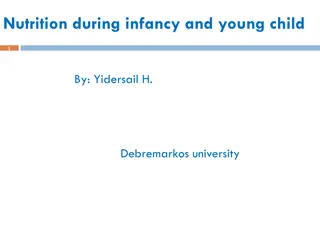Infant Suck Detection Interface Development
This project focuses on studying infant suck behavior and its correlation with weight gain. The collaboration aims to create a user-friendly GUI to analyze sucking signals and enhance data analysis methods. The device measures bottle nipple pressure, addressing issues such as data collection errors. The program's original problems are identified, and a new approach using MATLAB's strengths is proposed. Signal analysis involves exploring various methods to detect and classify sucking activity in premature infants during feeding.
Download Presentation

Please find below an Image/Link to download the presentation.
The content on the website is provided AS IS for your information and personal use only. It may not be sold, licensed, or shared on other websites without obtaining consent from the author.If you encounter any issues during the download, it is possible that the publisher has removed the file from their server.
You are allowed to download the files provided on this website for personal or commercial use, subject to the condition that they are used lawfully. All files are the property of their respective owners.
The content on the website is provided AS IS for your information and personal use only. It may not be sold, licensed, or shared on other websites without obtaining consent from the author.
E N D
Presentation Transcript
Infant Suck Detection Interface By: Amy Adair, Abiti Adili, Zachary Bradshaw, Joshua Brock, Brandon Dellucky, Heewon Hah, Margarite Laborde, Hugo Leiva, Miles Robicheaux, Sima Sobhiyeh, Zhaoxia (Mary) Wang, Jerome Weston
Collaboration with Pennington Their Goals Study infant suck behavior Analyze connection between infant sucking and weight gain Our Goals Create GUI to detect sucks in signal Improve methods of data analysis within the program
The Device and its Data What the bottle does Measures pressure on the bottles nipple Possible Issues Data Collection Error Seals If loose, skewed pressure values Reusable Chip Degrade? Different Chips Different results ? Device or Analysis?
Problems with the Original Program 1. GUI was not user-friendly Multiple Windows Slow Implementation of code was sloppy 2. Too many for loops Didn t use Mat Lab's strengths Matrix and Vector Operations Memory was not Pre-allocated Algorithms were inefficient 3.
Analysis of a Signal Previous Approaches Proper Orthogonal Decomposition Current Method Prototype was an average of several data samples Wavelet Transforms Reported not to work Neural Network Output not acceptable for testing data Correlation between data and NN trained with its parameters Detection, Identification and Classification of Suck, Swallow and Breathing Activity In Premature Infants During Bottle-Feeding by Fedra Adnani
Analysis of a Signal Noise vs Suck Correlation between prototype and data window Minimum width check Threshold check Original Prototype
Analysis of a Signal Original Algorithm First While Loop: Moves window step by step through the entire signal Second While Loop: Computes correlation coefficient until a window is found with sufficient correlation Checks that max min pressure is greater than threshold (after third loop is complete) Checks that window is less than size of widest suck Third Loop Second Loop First Loop Third While Loop: Adjusts starting point of data window to compute the optimal correlation coefficient Checks that window is greater than size of smallest suck
Analysis of a Signal Reordered Algorithm First While Loop: Moves window step by step through the entire signal Checks that norm of the signal is greater than threshold Third Loop Second While Loop: Computes correlation coefficient until a window is found with sufficient correlation Checks that window is less than size of widest suck Second Loop First Loop Third While Loop: Adjusts starting point of data window to compute the optimal correlation coefficient Checks that window is greater than size of smallest suck
Analysis of a Signal Loop Iterations For One Data Set Before Reorder After Reorder First Loop Only: 0 First Loop Only: 1,819 Second While Loop: 19,905 Second While Loop: 2,555 Third While Loop: 24 Third While Loop: 21 Total Iterations: 19,929 Total Iterations: 4,395
Solving Inefficiencies Problem: Original method of suck detection is slow because it performs a brute force template matching through the entire signal sample by sample. Our Solution: Obtain suspected suck positions. Then perform suck detection only on that small subset of containing initially estimated suck positions. Problem: Original algorithm performs template matching with every possible suck width at every position. Our Solution: Calculate an initial estimate of the suck width and only perform suck detection on a small neighborhood of the estimated suck width.
The Proposed Algorithm Pre-Processing Finding the Initially Estimated Sucks Perform Suck Detection on Initially Estimated Sucks
Block 1: Preprocessing Low pass filter ? (n) x(n) X(k) ?(k) Inverse Fast Fourier Transform Thresholding Function Fast Fourier Transform 1) Take Discrete Fourier Transform (DFT). 2) Threshold low frequencies 3) Inverse DFT.
Block 1: Preprocessing High pass filter Apply the Moving Average filter to smooth the signal. Once the signal has been preprocessed, we find the initially estimated sucks.
Block 2: Finding the Initially Estimated Sucks Threshold and Crop amplitudes smaller than the minimum suck strength. Threshold and crop original signal to remove all Find Local Peaks and Valleys Find local peaks and valleys of the thresholded signal. Calculate Widths Associates two valleys to each peak, the first valley as as the start and the second valley as the end of a suck. Reverting to Original Signal Positions Inserting the cropped sections back into the signal to obtain actual suck positions.
Block 3: Perform Suck Detection on Initially Estimated Sucks The original detection method uses template matching. This template is a simple parabola that acts as a prototype of a suck. Instead of using a parabola, we developed a prototype from the characteristics of the data. To build this prototype we used Proper Orthogonal Decomposition (POD).
Proper Orthogonal Decomposition (POD) The POD method allows us to create prototypes from the data itself. Allows for multiple prototypes as well More accurate than simple parabola
POD Analysis Procedure Take snapshots (??) of data Organize snapshots in a matrix (?) Form the symmetric correlation matrix (?) of this data Find the eigenvalues (??) and eigenvectors (??) of C N Real-valued eigenvalues ??= [ ??,1 ??,? ] | | | ?? | ?1 | ?2 | ? = ? = ?? ? 2 ? ? Orthonormal Basis Motivation: Minimization of Error ????? = ?? ????? ?=1 ?=1
POD Analysis Procedure (Contd) Choose eigenvectors based on dominant eigenvalues to store as prototype (?) Manual vs. Automatic ? = ?1,?2,?3, with eigenvalues ?1,?2,?3, ??? ? ?=1 ?=1 ? ?? (N is the total number of eigenvalues, m < N and is the number we use, and k is the cutoff)
POD Analysis Procedure (Contd) Now take the projection of the signal window onto ? Projection: 1 2 ?| ??, ? |2) | ? | ( ?=1 Using the user-specified cutoff, q, determine if the window is a suck ? Weighting: We also explored weighting each vector according to it s eigenvalue ?? ?? ??? ?=1 Further work: Spectral POD
POD GUI Takes the patients demographics Creates snapshots from sample data by selecting a start index and window size. When created, these snapshots are automatically resampled to all have the same length Saves/loads lists of snapshots to include in the creation of prototypes Generates and view the eigenvectors. Manual and automatic options are available to select the dominant eigenvectors. These eigenvectors will be the prototypes, which are the final out-puts of this GUI.
Future Plans Explore the possibility of different demographics having different suck types If true, build new prototypes for the different demographics using Spectral POD Apply the prototypes to signals of new babies Classify the babies based on how well their suck signals match the prototypes of their demographic























